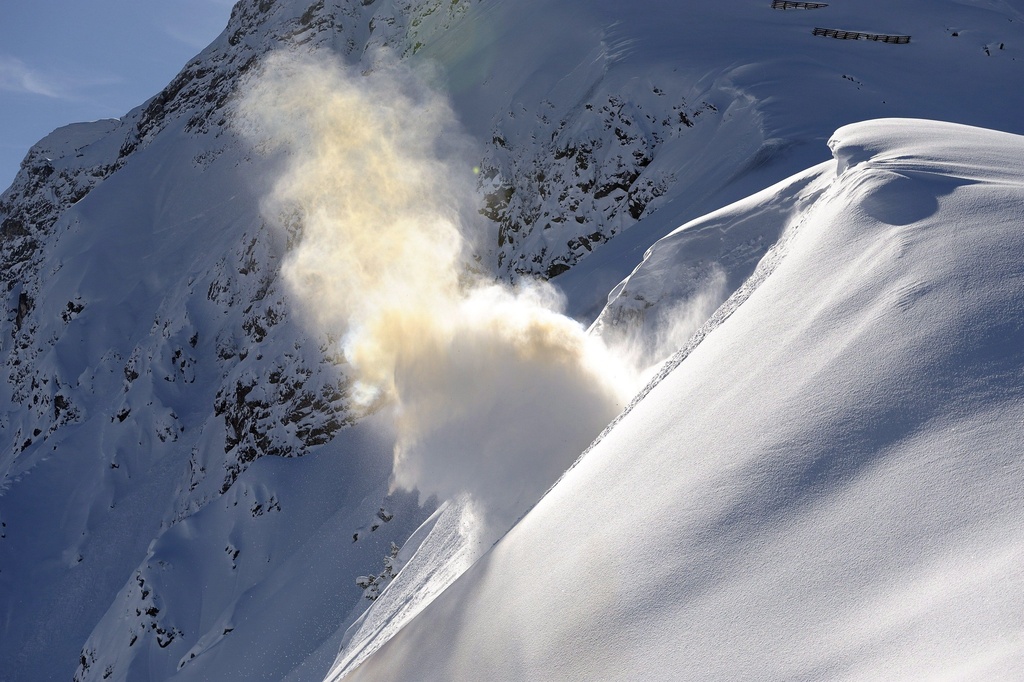
Avalanche blasts rise during record winter

The huge amount of snowfall this winter has led to at least three times more avalanche control explosions than normal.
Green groups are sounding the alarm over concerns that wild animals are being disturbed unnecessarily.
Every day teams of experts fly up into the mountains – normally in the early morning – to trigger avalanches. Their aim: protect ski slopes and roads from spontaneous avalanches.
The total number of detonations is expected to be much higher than normal. Daniel Antille, director of the explosives factory Société Suisse des Explosifs in Brig, canton Valais, expects delivery of explosives to increase threefold, as he told the Le Matin newspaper.
“I’ve also heard that it could be up to five times more than in a normal winter,” Lukas Stoffel, of the avalanche and protection team at the Institute of Snow and Avalanche Research (SLF), which is part of the Swiss Institute for Forest, Snow and Landscape Research, told swissinfo.ch.
Charly Wuilloud, head of natural dangers services in canton Valais, confirmed the trend. “There are places where we only made one or two blasts last year, this year it’ll soon be 30,” he said.
Conflict of interest
But although more explosions make it safer for humans, they cause animals in the affected regions increased stress.
“When it’s about human lives, it makes sense to trigger sporadic avalanches to make roads more safe,” said Roland Schuler, spokesman for the nature protection organisation Pro Natura.
“But Pro Natura is not happy when blasts occur over a large area, especially in ski areas, where the negative effects on wild animals are bigger.”
Stoffel understands the campaigners’ objections. He points out, however, that animals could also learn to move into safer areas when they hear helicopter noise, as they would associate that with avalanche detonations.
But this could also be a problem for animals, said Schuler. “Animals will flee when they hear helicopters, resulting in a huge expenditure of energy, which in some cases could be life threatening.”
Heavy snowfall
Schuler says the rise in avalanche triggering is down to the exceptionally strong snowfall this winter. “As long as this rise is not a trend, there is no need to overly dramatise the situation,” he said.
The alpine protection organisation Mountain Wilderness Switzerland also “recognises these explosions as a safety measure for mountain users”, according to its head of communications and fundraising, Priska Jost.
She adds that the increase this year could not be helped given the high amount of snowfall.
“But we would really welcome it if ski slopes could be constructed in such a way that these blasts are not necessary or at least could be kept to a minimum,” said Jost.
Unusual winter
There was a long wait for snow this winter, but when it came, snowfall was above average – especially between December 6, 2011 and January 22, 2012, said Stoffel.
The snow fell onto warm ground and was then compacted by strong winds.
“I have never seen a situation with so much snow and avalanches that can break off at any time of the day without any warning,” Wuilloud said. “An avalanche can suddenly start during the night or day and we don’t know how we can protect against it.”
The snow is very firmly pressed together in places, he added. “Explosives hardly shift it, so it’s very hard to decide whether sections of roads should remain closed or not – knowing that an avalanche could come at any time.”
Extra safety precautions, such as road closures, are necessary. “Luckily we haven’t had to evacuate any villages. But if more snow comes, we may have to,” said Wuilloud.
Unsuccessful blasts
Wuilloud says, however, that he has his doubts about the efficiency of avalanche explosions.
“We were successful with the first blasts this winter. But since the large snowfall and the strong wind, which pressed everything together, we have had less and less success.”
In one area 12 charges had to be detonated before an avalanche was triggered. And in St Anton in Austria it took 100 charges dropped from a helicopter to start one or two avalanches, he added.
Ferdinand Alber, head of the mountain railway in St Anton, confirmed the report, but said it was because of the special conditions this winter. “It has never been like this before,” he said.
Unsuccessful explosions are an assurance that the snow is not going to slide, said avalanche specialist Stoffel.
“The explosion is almost like a stability test,” he said. The decision whether to keep a road or ski slope open is therefore easier than if nothing had been done at all.
The Institute of Snow and Avalanche Research divides avalanche protection into several areas:
Structural avalanche protection: according to the SLF, Switzerland has invested around SFr1 billion ($1.09 billion) in protecting roads and settlements from avalanches.
Measures include defensive structures, avalanche dams, snow sheds (galleries or tunnels) for roads and rail, as well as protection for individual buildings.
Planning measures: affected areas are divided into different danger zones – high, middle, low and non-existent. Each zone is subject to its town rules for new buildings and evacuation. Avalanche maps therefore are often controversial.
Silvicultural measures: the SLF says that forests afford “effective and inexpensive protection against avalanches”. Measured by land surface area, forests are the most common form of avalanche protection. Around one third of the Swiss alpine region is covered in forest.
Temporary measures: used according to the conditions, especially for areas where structural measures are insufficient or are too expensive. The most important temporary measures are warning, closure and evacuation as well as artificial avalanche triggering.
(Adapted from German by Isobel Leybold-Johnson)

In compliance with the JTI standards
More: SWI swissinfo.ch certified by the Journalism Trust Initiative






























You can find an overview of ongoing debates with our journalists here . Please join us!
If you want to start a conversation about a topic raised in this article or want to report factual errors, email us at english@swissinfo.ch.